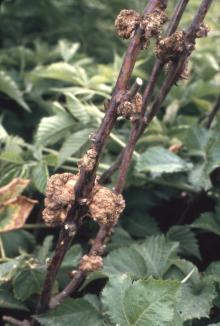Cause Agrobacterium tumefaciens and A. rubi are the two bacterial pathogens associated with crown gall on raspberry. Both pathogens reside in soil or on plant surfaces and can infect herbaceous and woody plants from many plant families. Once present in a field they can survive for years in the soil as saprophytes. They are spread by splashing rain, irrigation water, pruning tools, wind, insects, farm machinery, and on contaminated propagation material (cuttings, grafting stock). These bacteria are wound pathogens, and infection occurs through injuries to the crown and roots. Natural wounds include lateral root formation, leaf scars, and winter injury. Mechanical injuries occur during pruning, training, and harvesting. Infections occurring during the first growing season after planting are the most severe and can stunt or kill plants. Once infected, Agrobacterium causes plant cells to reproduce rapidly, resulting in swollen branches, roots, and gall formation. Crown gall is more severe in the presence of the root-lesion nematode and root-attacking insects.
'Willamette' is highly resistant; 'Nootka' and 'Canby' have intermediate resistance in the absence of nematode damage. 'Skeena', 'Chilliwack', and 'Haida' are susceptible.
Symptoms Crown gall is characterized by the presence of knobby galls on branches, the bases of canes, and on major roots. Young galls are a spherical mass of disorganized tissues and are cream-to-light-brown in color and soft and spongy in texture. Older galls turn brown-to-black and become woody and hard. They first appear in spring with the beginning of warm weather and increase in size during the summer. Galls may be scattered in discrete masses on infected roots and branches or they may occur in linear strips of contiguous bumps. Galls also may form at pruning wounds or where canes have been injured by bending or training. As galls grow larger, infected canes split and dry out. Symptoms on severely infected canes include stunting, leaf chlorosis, small and seedy fruit, wilting, and possibly death. In fall, galls near the soil darken and begin to decompose. Although galls may die over the winter, new galls may erupt the following spring near the old galls.
Cultural control
- Use certified nursery stock from fields where gall has not been found.
- Inspect planting stock and do not plant new canes that show galls on canes, crowns, or roots.
- Plant resistant cultivars.
- If only a few plants are infected, remove them from the field and destroy them.
- Establish new plantings on uninfested land wherever possible.
- Prune canes only during dry weather and frequently disinfect pruning equipment.
- Use care when harvesting and training, so not to injure canes.
- Preplant soil solarization has been helpful in reducing populations of certain soilborne pathogens and weeds in western Oregon. Place clear plastic (preferably anti-condensation film) directly on smooth, rototilled ground, which has been irrigated to field capacity and then allowed to drain for 1-2 days. Bury the edges of the plastic to trap the heat. Solarize for 4-6 weeks (or longer) during the hottest part of the summer, beginning in early- to mid-July.
Biological control Dipping the roots and crown area of blackberry plants in commercial preparations of the bacterium A. radiobacter K84 or strain K1026 before planting provided good protection for at least the first year, thus helping the plants to become well established. Follow manufacturer's directions. To be effective it must be applied a few hours after wounding. Change solution frequently because if a set of plants contaminated with other pathogens is dipped then all succeeding plants dipped into the same container/solution will become contaminated.
- Galltrol-A (Agrobacterium radiobacter K84). Not registered in Idaho. 12-hr reentry. O
- NOGALL at 8.8 oz/2.5 gal unchlorinated water per 2,500 nonbearing plants. Apply within 2 hours of lifting and/or damaging plants. Do not use with any pesticides or fertilizers. 4-hr reentry. O
References Martin, R.R., Ellis, M.A., Williamson, B., and Williams, R.N. 2017. Compendium of Raspberry and Blackberry Diseases and Pests. 2nd edition. St. Paul, MN: APS Press.



